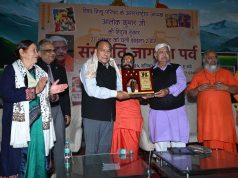By Arun Pratap Singh
Garhwal Post Bureau
DEHRADUN, 22 Nov: Despite Uttarakhand marking twenty-five years as a State, the historic Kandi Road, once widely known as the Sub-Mountain Road, remains only a dream. This nearly two-century-old route, integral for linking the Kumaon and Garhwal divisions and it can drastically reduce travel distance between the two regions. A renewed sense of optimism has emerged following a recent Supreme Court order, offering a chance that this long-pending construction may finally see the light of day.
For generations, the Kandi Road has been considered indispensable. Extending from Brahmadev Mandi in Tanakpur to Kotdwar, it once demarcated the border separating the hills from the plains. During the British administration, government employees posted along the upper stretches received hill allowances, setting a clear distinction between staff above and below the road and reinforcing its association with the identity of the mountain region. The demand to construct or restore this road dates back long before Uttarakhand was carved out as a separate state. However, after the formation of Uttarakhand as a separate state, though, hopes for construction of this road were rekindled, no concrete step was taken by the successive governments to get this project completed regardless of whichever party remained in power. To compound the matter, environmental clearances and concerns remain a serious issue that has led the governments stay away from the project which has not moved beyond the files so far.
It may be recalled that this route, connecting Ramnagar to Kotdwar, incorporates a 43-kilometre segment through the Corbett Tiger Reserve. Earlier, buses operated on this stretch but services were halted following a court directive. In 1999, permission from the Centre allowed public movement, and later, the Uttarakhand Government proposed an all-weather road. However, when various NGOs challenged the plan in the Supreme Court, raising worries about dangers posed to tigers and other wildlife, the Kandi Road got entangled in legal disputes, suspended amidst conservation objectives and the urgent need for development. Particularly disappointing was the absence of robust advocacy by successive state governments before the courts, prolonging the deadlock.
Corbett National Park Director Saket Badola stated that with the issue currently sub judice, further steps can only be taken after a thorough review of forthcoming judicial directives. Over the years, several political leaders attempted to give fresh impetus to the project, including former Chief Ministers Narayan Datt Tiwari and Trivendra Singh Rawat, former MP Tirath Singh Rawat, Rajya Sabha MP Anil Baluni, and even former Forest Minister Harak Singh Rawat. Their efforts, encompassing surveys and proposals, have consistently failed to progress beyond elementary stages, leaving the Kandi Road as an electoral promise rather than an earnest administrative pursuit.
The strategic significance of the Kandi Road cannot be overstated. It is the shortest route between the Garhwal Regiment Centre (Lansdowne) and the Kumaon Regiment Headquarters (Ranikhet), critical not only for military logistics but also for civilian movement. Due to closure of the corridor, residents must now have to traverse the longer Uttar Pradesh route via Najibabad, turning a manageable journey of 88 kms into one spanning 165 kms. Completion of the Kandi Road would greatly benefit people by saving time and money, reducing fuel usage and pollution, and stimulating trade, tourism, and deepening cultural ties between Kumaon and Garhwal.
PC Joshi, president of the Kalagarh Kandi Road Construction Struggle Committee, reminisced about approaching the Supreme Court in 2005 and subsequently being referred to the High Court. In 2010, the High Court leaned towards approval, but in 2014, opposition from over two dozen NGOs forced Joshi to retract his petition. He observed that while environmental issues are often cited, the system designed to articulate public needs remains relatively weak in comparison. The environmentalists are a strong lobby in the country and they claim that the construction of Kandi Road will have serious implication for the tigers and other wild animals from Corbett Tiger Reserve.
A turning point arrived with the Supreme Court’s November 17 directive, as the bench called for a uniform policy for all national parks nationwide, balancing conservation with the rights and interests of local residents. Joshi has described this as a landmark opportunity for the Kandi Road, as the order clarifies how developmental projects within tiger reserves and sanctuaries might move forward, potentially resolving the longstanding impasse.
According to the Struggle Committee, the route, which was once accessible under a permit system, has remained entirely closed since 2018. Local agitation for its reopening continues, but successive governments have stayed the course of inaction due to conservationist pressures. Now, with the Supreme Court’s latest order, plans are afoot to organise a joint meeting of activists from Kumaon and Garhwal, aiming to intensify public advocacy and finally nudge the government towards long-awaited action on the Kandi Road.
One way to minimise effect of vehicles traversing through the Corbett National Park on this Kandi road is to construct an elevated road with sound barriers, but no one has spoken about it or proposed this.







